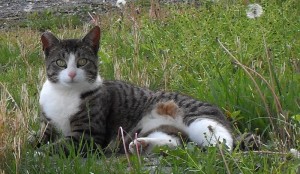 This blog post was written by Laurie Goldstein.
This blog post was written by Laurie Goldstein.
Alley Cat Allies created National Feral Cat Day in 2001 as the annual kick-off for its national educational campaign about community cat care with TNR. For many in the trenches, it has been an uphill battle. But this year’s theme says it all – Evolution of the Cat Revolution. There are now over 450 cities (including New York City and Chicago) and counties with official ordinances or policies endorsing TNR, and there are more than 600 nonprofit groups across the country practicing TNR.
What is TNR? With trap-neuter-return, all the feral cats in a colony are trapped, sterilized, often vaccinated and provided medical care if needed, then returned to the territory where they were trapped – where colony caretakers provide food, water, and shelter. Young kittens that can be socialized and friendly adults (strays) are pulled and placed in foster care until they can be adopted out into loving homes.
Why TNR? Sterilizing the cats immediately stabilizes the size of the colony by preventing new litters. If there are kittens or friendly adults, the colony is reduced by pulling them for adoption. The nuisance behavior associated with feral cats is reduced or eliminated, as almost all of those behaviors are related to mating and territory marking – hormone driven behaviors. The returned cats guard the territory, often preventing intact cats from moving in to access the food source and re-initiating the cycle of breeding and problem behaviors. And let’s not forget, the cats do provide rodent control. From a sheltering standpoint, returning feral cats to their community reduces the number of cats being admitted to shelters. This means less killing and focusing on adoptions of friendly cats.
But don’t cats kill birds? A topic that has become intertwined with how best to manage feral cat populations is that of feline predation and the effects on wildlife populations. As CatCentric readers are intimately aware, cats are obligate carnivores. For cats, predation is a natural part of life; they must eat small prey animals in order to survive. Because of this, the topic of cat predation has become a battleground of propaganda, rhetoric, competing “studies,” and experts. A study supporting any stance can be found, and these studies are often cited and quoted – or intentionally misrepresented. The bottom line is that despite a century of cat predation research, there is simply no strong support for the viewpoint that cats are a threat to wildlife, except where there are fragile populations in isolated or fragmented ecosystems. Almost all studies of cat predation focus on quantifying it: but very, very few have studied the actual impact of that predation. In fact, according to the Royal Society for the Protection of Birds in the UK:
“Despite the large numbers of birds killed, there is no scientific evidence that predation by cats in gardens is having any impact on bird populations UK-wide. This may be surprising, but many millions of birds die naturally every year, mainly through starvation, disease, or other forms of predation. There is evidence that cats tend to take weak or sickly birds. We also know that of the millions of baby birds hatched each year, most will die before they reach breeding age. This is also quite natural, and each pair needs only to rear two young that survive to breeding age to replace themselves and maintain the population.
It is likely that most of the birds killed by cats would have died anyway from other causes before the next breeding season, so cats are unlikely to have a major impact on populations.”
TNR is the only effective, humane approach to community cat management. A former President of the National Animal Control Association (NACA), Mark Kumpf, likened the outdated approach of catch-and-kill as “bailing the ocean with a thimble.” According to Mr. Kumpf, “…the old standard isn’t good enough anymore. As we’ve seen before, there’s no department that I’m aware of that has enough money in the budget to simply practice the old capture and euthanize policy; nature just keeps having more kittens.” (“Taking a Broader View of Cats in the Community,” Animal Sheltering, September/October 2008). In 2008, under Mr. Kumpf’s leadership, NACA joined the many cities and counties around the country and embraced TNR.
For more information on how you can help feral cats, check out these articles:
Socializing a Feral Cat: It’s all about Trust
Trap-Neuter-Return (TNR): Effective, Affordable, Humane Community Cat Management
And for more information on the management of feral cat colonies, including building winter shelters, see the following websites:
If you enjoyed this post or found it informative, please “Like” it, “Tweet” it, or share it using any of the buttons below. And don’t forget to check out our FB page, join the discussions in our awesome FB group and follow us on Twitter!

